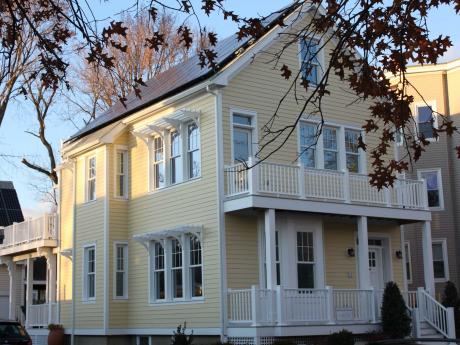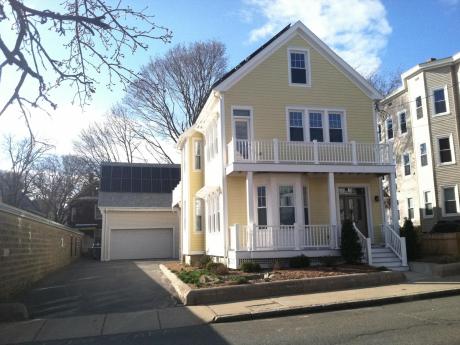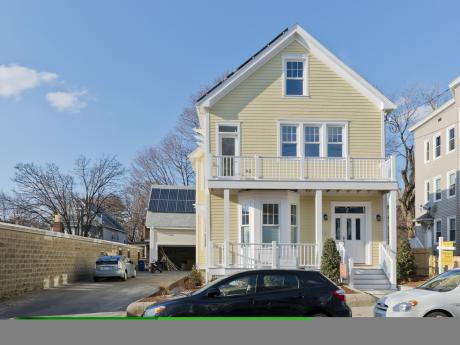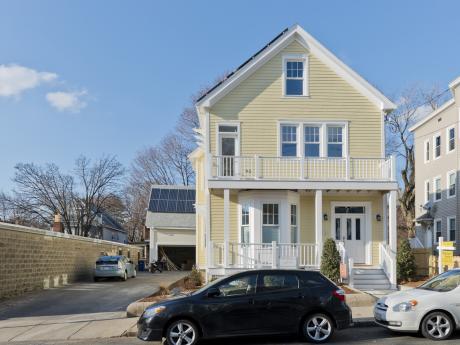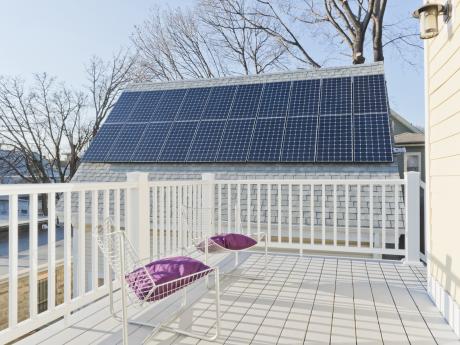The Davis House
Project Photo Gallery
Project Team
![]()
Franziska Amacher, FAIA, NCARB, LEED AP, WBE, has over 30 years of experience in design and project management.
After graduating with a MA from the Harvard Graduate School of Design she worked for several firms, including Sert Jackson and Baumann Frey an award winning firm in Switzerland. She also worked independently as an Architect for residential projects and as developer for nine projects in her firm, Archimage. From 1991 to 1996 she was a principal in the firm Amacher Quinn. Since 1996 she has managed her own firm Amacher and Associates.
Throughout her career in her practice and as former Co-chair of COTE at the Boston Society of Architects and current Board Member of Architects, Designers and Planners for Social Responsibility (ADPSR.org), former board member of ARC-Peace, the Association for Public Transportation and as Trustee for the Riverbend Park Trust, Franziska promotes sustainable design practices to foster human and environmental health in her buildings and in her work to foster the quality of life for communities.
Her projects included the design of residential communities such as the first built cohousing community in the Boston area, as well as a 30 unit live/work artist community in a converted factory. Another prize-winning project was the conversion of a historic building on a main street to 8 affordable housing units and 3 commercial units. Some of her residential projects were filmed for TV shows. She has designed a number of energy efficient buildings, including net zero houses, a number of deep energy retrofits and planned several net zero mixed-use communities.
Franziska has taught sustainable architecture for several years at the Wentworth Institute of Technology.
Franziska has promoted health and education amongst communities. In 2008 she inspired a school to build a schoolyard garden. She designed it and another community garden and playground nearby. She co-produced & designed the site layout for the Boston Green Fest on Boston City Hall Plaza . In 2012 she redesigned Boston City Hall Plaza for the Foundation for a Green Future. As former teacher at Wentworth Institute of Technology and founding member of the Green City Team she was a key member of the four who to developed a redesign for Boston City Hall that is featured on the BASEA web site and was presented to the Boston City Council.
This renovation transformed this building from an energy guzzler to a resilient and healthy spacious 2-family, designed to use less energy than it produces. Careful planning resulted in high efficiency of the building envelop, of the heating, cooling and ventilation systems. The solar panels provide the energy needed to run this two family.
This is important because:
Existing structures, outnumbering new housing nearly 300-to-1
"The greenest building is the one that’s already built, in almost every case.”
There are 130million housing units that already exist. 80 % will still be here in 2050. This is where many of our efforts should be.
The goal was to reduce the energy use and increase the usability of the building within the same footprint by:
New envelop: Roof R-60 to 62.5, Walls R-48, Bsmt-Walls R-23, Slab R-20 3 pane windows: (SW,
NW,NE) U 0.21, SHG 0.19, VLT 0.32
(SE) U 0.25, SHG 0.31, VLT 0.34
Retained 60% more solar gain on the SE for passive solar heat.
Windows added by 50% to South, removed by 50% to North
Provided solar shading ACH .85 to 1.2 @ 50P
Equipment:
A hybrid solar system with 56 Sunpower solar panels for PV combined with 12 Sundrum panels attached
under the PV panels provide power and hot water. The hot water is for
both domestic use and for the basement radiant slab.
3 minisplits per unit provide both heating and cooling.
Each unit has a HRV which provides preconditioned air to all rooms and works with booster fans to
exhaust bath and kitchen air. The condensing washer-dryers don’t require an exhaust fan. With these
strategies we minimized the number of exterior envelop penetrations from the mechanical equipment
and provide for a much healthier indoor
environment with constant fresh air supply
Each unit has a HRV which provides preconditioned air to all rooms and works with booster fans to exhaust bath and kitchen air. The condensing washer-dryers don’t require an exhaust fan. With these strategies we minimized the number of exterior envelop penetrations from the mechanical equipment and provide for a much healthier indoor environment with constant fresh air supply.
Layout:
Redesigned layout with combined rooms for spaciousness. Expand interior to exterior with decks and added windows. Expand living space to basement & in attic by lowering floors and adding daylight.
Minimize visual clutter, use transparent materials (see stairs).The sustainability of the design is enhanced by resource efficiency: many of the building materials used are reused or recycled, for example bathroom floor tiles are the former slate roof. The floors were reinstalled. Demolished chimney bricks were reused. One staircase was rebuilt, a stair and cabinet built with wood from a nearby demolition site, recycled ceramic tiles and recycled tire decking etc.
The healthy indoor environment is due to using no or low off-gazing building materials and a continuously operating ventilation fan supplied preheated out door air. The redesigned room layout assures the spacious feel for the interiors. Although the apartments are small, about 1360 SF, with a lot of daylight and transparent adjacencies between the non-private rooms, the space feels generous. New decks also expand the interior spaces to the exterior.
Recycled furniture in both apartments complete the sustainability of the project.
Quick Facts
General
| Location | Somerville, Massachusetts |
|---|---|
| Building Type | 2-family residence |
| Project Type | |
| Basis of Performance Claim | |
| Conditioned Floor Area | 3,130 sq ft |
| Total Cost of Project | $761,064 |
Energy Summary
| Energy Data Type | |
|---|---|
| Renewable Energy System Type(s) | |
| Ratings | |
| HERS Index | -4 |
| Net electricity usage (purchased) | 45,084 kWh/year |
| Annual renewable energy generated | 8,586 kWh/year |

